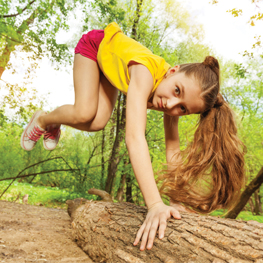
By now, most of us know that we need to limit screen time for our kids and get them moving, but we know less about what kind of movement our kids need and why it is so critical for their overall development. We want opportunities for our kids to be ready to learn and to be successful in school. For instance, we might worry that our three-year-old can’t write their name yet, or we might brag about our four-year-old’s good reading ability. But I’ll let you in on a secret: The easiest, most affordable, and powerful developmental opportunity you can provide for your child is to allow them the space and time for unstructured, active, outdoor play in nature. Here’s why.
Gross motor development
Development occurs first in the large muscles and core muscles of the body before the smaller muscles. For example, a baby has to first master sitting up before they learn how to play with a toy with their hands. A child cannot print efficiently until they have the core and shoulder strength to stabilize their writing arm and hand. Nature provides the perfect backdrop for practicing large-body movements. There are trees, logs, and rocks to climb and jump off of, long grass to navigate through, uneven ground to move over, hills to climb and run down, opportunities to manipulate sticks, rocks, dirt, water.
Nature is always changing, so these full-body, sensory-rich experiences are unique each time, and they challenge the body to adjust and adapt. Structured sports for kids are wonderful, but they encourage the body to move in the same patterns again and again, over-developing some areas and under-developing others. The 2015 ParticipACTION Report Card on Physical Activity of Children and Youth reports that when kids are outside, they move more and play longer, especially when an adult is not directing their play. Nature play takes that one step further; even outdoor playgrounds do not compete with nature play. When comparing kids who play on a black-top playground with kids who play in the woods, a study out of Norway published in the Early Childhood Education Journal, The Natural Environment as a Playground for Children: The Impact of Outdoor Play Activities in Pre-Primary School Children, found significantly better gross motor skills in the group that played in the woods.
Sensory development
Teachers are finding an increase in children who don’t like getting their hands dirty, can’t sit still in class, bump into each other in the hallways, can’t regulate the force of their touch when playing tag, and even fall out of their desks. All of these concerns point to under-development of sensory systems. In order for senses to develop and integrate properly, a child must have a variety of sensory experiences; their body learns to accurately take in sensory information from the environment, organize it in the brain, and respond to it in a way that helps the body have an effective interaction with the environment. Today, many children are not having enough of these sensory experiences.
Nature play offers what paediatric occupational therapist Angela Hanscom calls in her book, Balanced and Barefoot: How Unrestricted Outdoor Play Makes for Strong, Confident, and Capable Children, the “just-right sensory experience.” There is a reason that being in nature is calming for us - the colors are lively without being too bright, the sounds of birds and leaves in the wind are soothing, and the smells of the great outdoors are generally pleasant. We can have sensory-rich experiences without being bombarded by fluorescent lights, beeping devices, or stale indoor air. Forget purchasing fancy sensory bins and products for your kids. Developmentally, kids need to dig, pick up rocks, get muddy, lie in the grass, get cold hands from spending time outdoors, and smell the leaves. They need to experience rolling, spinning, falling, climbing, and swinging in the outdoors.
A well-functioning sensory development is crucial in order for kids to be physically and mentally ready to learn, and for them to successfully explore and experience the world around them.
Easy, fun activities for nature play
Getting your kids out playing in nature should not be a lot of work, and it should be largely child-driven. We don’t need to tell kids ‘how’ to play, they are already the experts, and sometimes an adult’s agenda can take away some of this magic! However, we can set up opportunities to peak their interest and get them started in nature play. Then it’s time to back off, supervise from a distance, and follow their lead if they want us to join in!
Here are some easy ways to inspire nature play for your child:
Devon Karchut, MScPT, is a mom of an adventurous four-year-old and passionate outdoor play advocate. She is a paediatric physiotherapist at Lead Foundation, as well as the owner of TimberNook of Greater Calgary, a nature play program that provides innovative play experiences for children of all ages. For more details, visit timbernook.com.
Calgary’s Child Magazine © 2024 Calgary’s Child